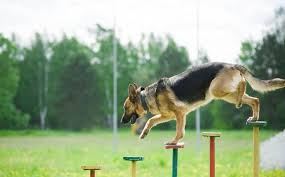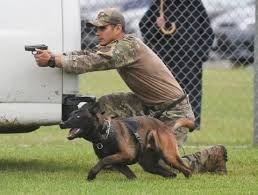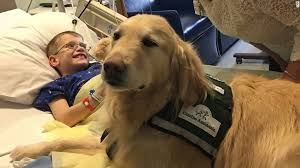So, everyone has heard of police officers, but not everyone has heard of police dogs. Let it be know, police dogs do not pull people over or arrest criminals, that’s only in the movies. Police dogs come from a specific breed that are able to perform specific tasks that police dogs need to accomplish. While some dogs are used as guide dogs, search-and-rescue dogs, and bomb or drug sniffing dogs, very few dogs are asked to give as much as themselves as police dogs. With this, police dogs are used to track criminals, sniff out illegal materials, search buildings, and do other jobs that human police officers are incapable of doing.
Why do we use police dogs? There are many things that dogs can do that humans cannot. For example, a dog’s sense of smell is fifty times more sensitive than a human’s sense of smell. With this, a dog is able to sniff out criminals, drugs, weapons, and bombs in situations where it would be impossible for a human to do so. Along with having a very strong sense of smell, a dog always has a very picky sense of smell. A dog can discern a scent from a dozens of other smells around them. THis is why dogs are able to find drugs that are wrapped in towels soaked with perform because they are able to find that one specific smell. Another reason why we use police dogs is because of their sizes. Some dogs are able to fit into small spaces. Dogs are able to search through rubble during search and rescues and go through smaller spaces to get somewhere faster.
Some important qualities and characteristics of a police dogs are that they are intelligent, aggressive, strong, and have a good sense of smell. Many police dogs are male and are frequently left unneutered so they can maintain their natural aggression. However, this aggression is kept very close in check with rigorous and thorough training. Police dogs can come from many different sources. While some dogs are donated by their original owners, some dogs are now being specifically bred and raised for police work. Even more often, dogs are imported Europe because of the way they are bred. In Europe, breeding standards are much more strict than in America; dogs are measured by a core set of physical attributes and they are only bred if they meet those criteria. Also, European police dog agencies are internationally renowned and when graduating from the academies, receive an international certification.
While any dog can be trained as a police dog, the most popular police dog breeds are:
- Belgian Malinois
- German Shepherd Dogs
- Bloodhounds
- Dutch Shepherds
- Labrador Retrievers
These breeds are known for their incredible working ability and their desire to cooperate with humans and handlers. These dogs are the easiest and most compatibility with training to be a police dog.
There are three major disciplines that police dogs are focused on when they are on the force:
- Apprehension
- This is the most popular discipline of the police dog. Dogs are trained to bite suspects who seem dangerous and hold them hostage if necessary. Also, police dogs are the first ones to put their lives on the line and put themselves in danger in order to protect their human partners. They must be stable and know when someone is a threat and also know that they have to act solely on the command of their handlers.
- Detection
- Dogs use their amazing sense of smell when it comes to fighting crimes and catching criminals. As said before, dogs are used to detect drugs, explosives, and other crime scene evidence. The dogs are able to perform their tasks anywhere but especially at airports and border entries. Dogs can also be trained to detect landmines in order to protect their handlers from danger.
- Search and Rescue
- One of the biggest parts of police work is searching for lost victims whether that be through a kidnapping or a missing person. With this, dogs can be trained to find living victims based on their scents or even find the remains of a deceased human. Dogs are also able to search through rubble and cover miles of to look for a lost hiker, someone buried in an avalanche, or even locate the bodies of victims under water. Dogs are able to cover large areas in a short amount of time which makes them a great resource when looking for victims.
If you would like to make a donation to the National Police Dog foundation to help them continue to train dogs in making the world a safer place, click here!


























Recent Comments